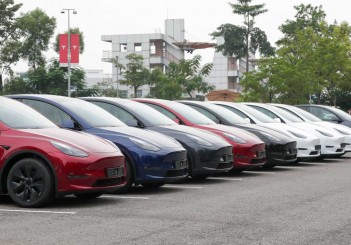At the same time, the tyres are expected to perform well in ride comfort, good fuel mileage as well as in grip and stability through winding roads.
Continental AG has obviously received its fair share of feedback in these areas and has focused its development efforts to come up with a tyre that is as quiet as it should be to complement current car developments while not compromising other areas of tyre performance.
Its latest tyre product is the PremiumContact 6 that is meant to take over the role of the ContiPremiumContact 5 and ContiSportContact 5.
By design, based on the tyre name, the former is designed more for premium motoring where comfort is prized higher than sporty driving and that is where the latter tyre is better sought after.
With the PremiumContact 6, Continental has decided to up the game by providing a tyre that would meet premium comfortable motoring needs while catering to sporty driving as well.

It’s all a matter of providing the best mix of ingredients that go into the making of a tyre, from the tread pattern, sidewall design to the blend of rubber and chemical composition that would yield the desired level of performance.
In developing the PremiumContact 6, Continental used the ContiSportContact 5 as the benchmark to achieve the sporty aspect while not forgoing the comfort side.
The eventual product was found to improve in almost all areas of tyre performance; handling up 3%, mileage improved by 15%, exterior noise quieter by 10% and interior noise by 2% while matching the ContiSportContact 5 in dry and wet braking, and rolling resistance.
It only lost out in hydroplaning or aquaplaning by 5%, which was considered acceptable with the bigger footprint.
Continental sees this as a successful resolution of what it calls ‘target conflicts’ in achieving the optimum in dry handling (stiffness of tyre), wet braking (softness) and rolling resistance (softness) through tyre compounds and tread pattern.
It also developed the tyre according to vehicle dynamics, especially in how the tyre would complement the car when taking corners, described as another target conflict.

That too, Continental says, its PremiumContact 6 would provide the steering precision and stability to enjoy a ‘fun to drive’ experience in the car.
The proof of the pudding is in the driving and this was gained at the Monteblanco Circuit in Seville, Spain where we participated in three driving routines, each to sample a different aspect of the improved tyre performance.
The first was the public road drive, albeit a short one of about 2km covering the approach roads to the circuit at speeds between 40 and 70kph.
Four Mercedes-Benz E220d were provided; two had ContiPremiumContact 5 tyres (225/55 R17, the biggest for this range) and the other two ran on PremiumContact 6 (245/45 R18).
We were to experience the routine in the same order, i.e. as driver or as passenger when moving from one car to the other; we experienced that feel as a rear passenger.
There was no difference in tyre noise as both new and old ran as quiet as could be expected and it was only in road impacts that the difference was discerned, especially when running over bumps.
We felt an extended resonance of the road impact with the ContiPremiumContact 5 while that of the new PremiumContact 6 was short and sweet; just a thud.
That made the ride more comfortable as you don’t feel the road impact any more than necessary.

The second routine was driving three fast cars - Volkswagen Golf GTi, Subaru WRX and Renault Megane RS275 – that were all shod with the PremiumContact 6 tyres, with pressures set to the respective car manufacturer’s recommendations.
We followed a pace car for three laps around a short section of the circuit (1.3km) with mostly corners turning right and one left at full bore speeds; braking hard into the corners and accelerating hard out.
Good directional feel of the PremiumContact 6 tyres was enjoyed for the quick corner bashing, especially in the Golf GTi with its automatic transmission (245/40 R18).
The impressive part was not hearing the tyres squeal when the cars were pushed through the corners.
We found it a hassle shifting gears for the manual transmission Subaru WRX (we did not drive the Renault as it was another manual transmission car) and kept mostly in third and fourth, falling somewhat behind the pack except on the short straight.
Nevertheless, we were pushing the car fast enough through the corners and still didn’t hear the tyres (225/40 R18) protesting audibly.
The third routine was in experiencing the improved stability and grip of the new PremiumContact 6 against the ContiSportContact 5 and ContiPremiumContact 5 in a BMW 640d.
We felt this was a little flawed; although the cars were the same, each car was in a different state of wear and tear, considering that we were the last media group to enjoy this experience.
This drive routine had us going through slaloms at a constant 90kph, taking a particular corner at 100kph and doing lane changes at 80kph to 90kph to gauge entry and rear stability.
We turned the steering less with the ContiSportContact 5 and new PremiumContact 6 (based on the gauge fixed behind the steering wheel), while we had to work the steering more with the ContiPremiumContact 5 while covering three laps each in the BMWs with the respective tyre.
Improved rear stability was felt in the Bimmer with the PremiumContact 6 and it was the ContiPremiumContact 5 that squealed a little when the vehicle was pushed through the corners.
Continental came up with a measuring system to gauge tyre improvements in the respective area using a BMW 640d that ran on different tyres so that results were consistent.
And this equipment used for the exercise was said to cost more than double that of the price of the BMW 640d!
That’s plenty of money Continental is willing to spend to ensure its final products are top-notch.










